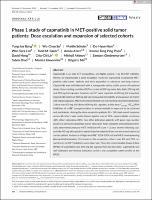Phase 1 study of capmatinib in MET-positive solid tumor patients: Dose escalation and expansion of selected cohorts
Author
Date
2020-02Permanent link
https://hdl.handle.net/11351/6502DOI
10.1111/cas.14254
ISSN
1349-7006
WOS
000504804900001
PMID
31778267
Abstract
Capmatinib is an oral, ATP-competitive, and highly potent, type 1b MET inhibitor. Herein, we report phase 1 dose-escalation results for capmatinib in advanced MET-positive solid tumor patients and dose expansion in advanced non-lung tumors. Capmatinib was well tolerated with a manageable safety profile across all explored doses. Dose-limiting toxicities (DLT) occurred at 200 mg twice daily (bid), 250 mg bid, and 450 mg bid capsules; however, no DLT were reported at 600 mg bid (capsules). Capmatinib tablets at 400 mg bid had comparable tolerability and exposure to that of 600 mg bid capsules. Maximum tolerated dose was not reached; recommended phase 2 dose was 400 mg bid tablets/600 mg bid capsules; at this dose, Ctrough >EC90 (90% inhibition of c-MET phosphorylation in animal models) is expected to be achieved and maintained. Among the dose-expansion patients (N = 38), best overall response across all cohorts was stable disease (gastric cancer 22%, hepatocellular carcinoma 46%, other indications 28%); two other indication patients with gene copy number (GCN) ≥6 achieved substantial tumor reduction. Near-complete immunohistochemically determined phospho-MET inhibition (H-score = 2) was shown following capmatinib 450 mg bid capsule in paired biopsies obtained from one advanced colorectal cancer patient. Incidence of high-level MET GCN (GCN ≥6) and MET-overexpressing (immunohistochemistry 3+) tumors in the expansion cohorts was 8% and 13%, respectively; no MET mutations were observed. Thus, the recommended phase 2 dose (RP2D) of capmatinib was 600 mg bid capsule/400 mg bid tablet. Capmatinib was well tolerated and showed antitumor activity and acceptable safety profile at the RP2D.
Keywords
MET amplification; Capmatinib; Solid tumorsBibliographic citation
Bang YJ, Su WC, Schuler M, Nam DH, Lim WT, Bauer TM, et al. Phase 1 study of capmatinib in MET-positive solid tumor patients: Dose escalation and expansion of selected cohorts. Cancer Sci. 2020 Feb;111(2):536–547.
Audience
Professionals
This item appears in following collections
- HVH - Articles científics [4476]
The following license files are associated with this item:

 Private area
Private area Contact Us
Contact Us








